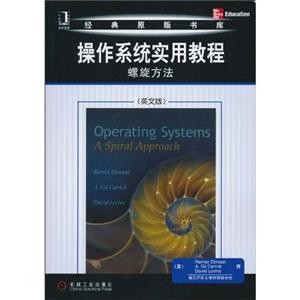操作系统实用教程-螺旋方法-英文版
节选
[
《操作系统实用教程:螺旋方法(英文版)》采用螺旋方法和深度导向方法讲解操作系统原理。首先介绍一些基本的背景和定义,然后描述一个非常简单的操作系统,之后将它演化为具有更多特性的更复杂的操作系统。这样循序渐进、逐步深入,可以使学生更透彻地理解操作系统的本质。《操作系统实用教程:螺旋方法(英文版)》分为六个部分:**部分介绍一些总体背景信息;第二部分采用螺旋方法,按照复杂度递增的次序。介绍五类操作系统;第三部分到第五部分采用深度导向方法详细地探讨操作系统的各个主题:从进程到内存管理.再到文件系统;第六部分通过三个实例更深入地研究这些系统的特性是如何实现的。
]
本书特色
[
《操作系统实用教程:螺旋方法(英文版)》特色:对于所讨论的操作系统。书中适当介绍一些当时的行业历史,有时还涉及关键的企业或个人,这样能帮助学生更好地理解操作系统。涵盖在设备中的现代操作系统,而不仅仅是通常的计算机中的操作系统。讨论算法级解决方案,而没有列出实际代码。便于使用不同编程语言实现。每章末都有一些练习题.便于学生巩固所学知识。
]
作者简介
[
作者:(美国)埃尔玛斯里(Ramez Elmasri) (美国)加里克(A.Gil Carrick) (美国)莱文(David Levine)Ramez Elmasri,得克萨斯大学阿灵顿分校教授。他于1980年在美国斯坦福大学获得计算机科学硕士和博士学位。其研究兴趣是传感器网络和RFID、生物信息介质、查询个性化和系统集成。A. Gil Carrick,曾执教于得克萨斯大学阿灵顿分校。他是计算机科学荣誉协会Upsilon Pi Epsilon的成员。David Levine,一直讲授操作系统、软件工程、网络和计算体系结构等课程。他的研究兴趣包括移动计算、移动对象和分布式计算。
]
目录
Preface viPart 1 Operating Systems Overview and BackgroundChapter 1Getting Started1.1 Introduction 1.2 What Are Operating Systems All about?1.3 User veusus System View of an OS 1.4 Some OS Terms. Basic Concepts, and Illustrations1.5 A Small Historical Diversion 1.6 Summary Chapter 2Operating System Concepts, Components and Architectures 2.1 Introduction:What Does the OS DSs2.2 Resources Managed by the OS and Major OS Modules2.3 The Process Concept and OS Process Information2.4 Functional Classes of OSs2.5 Architectural Approaches to Building an OS 2.6 Some OS Implement Techniques and Issues2.7 Minimalist versus Maximalist Approaches to OS Functionality and Back ward Compatibility2.8 SummaryPart 2Building Operating Systems Incrementally:A Breadth-Oriented Spiral Approach Chapter 3A Simple,Single-Process Operating System 3.1 Introduction:Monitors and CP 3.2 Characteristics of a Simple PC System3.3 Input Output Management 3.4 Disk Management and the File System3.5 Process and Memory Manage me3.6 SummaryChapter 4A Single-User MultitaskingOperating System4.1 Introduction:A Simple Multitasking System4.2 The Palm OS Environment and System Layout4.3 Process Scheduling and System Layout4.6 Basic Input and Output4.7 Display Management4.8 Event-Driven Programs4.9 Summary Chapter 5A Single-User Multitasking/Multithreading Operating System5.1 Introduction 895.2 The Origin of the Macintosh Computer5.3 The Macintosh OS——System5.4 System25.5 System35.6 System45.7 System55.8 System65.9 System75.10 System85.11 System95.12 Mac OS X5.13 SummaryChapter 6A Multiple-User Operating System6.1 Introduction6.2 The Multiuser OS Envtronment6.3 Processes and Threads6.4 SummaryChapter 7Parallel and Distributed Computing, Clusters, and Grids7.1 Introduction7.2 Key Concepts7.3 Parallel Distributed Processing7.4 Distributed System Architectures7.5 How Operating System Concepts Differ in SMPs, Cluster, and Grids7.6 Examples7.7 SummaryPart 3CPU and Memory ManagementChapter 8Process Management: Concepts, Threads, and Scheduling8.1 Introduction to Processes8.2 Process Descriptor-Processes Control Block8.3 Process States and8.4 Process Scheduling8.8 0ne Good Process Deserves Another8.6 Threads8.7 Case Studies 8.7 Summary Chapter 9Mere Process Management : Interprocess Communication, Synchronization, and Deadlocks9.1 Why Have Cooperating Processes?9.2 Interprocess Communication9.3 Synchronization9.4 Deadlocks9.5 SummaryChapter 10Basic Memory Management10.1 Introduction: Why Manage Primary Memory?10.2 Binding Model: Steps in Development Cycle10.3 A Single Process10.4 Multiple Processes with a Fixed Number of Processes 10.5 Multiple Processes with a Variable Number of Processes10.6 Summary Chapter 11Advanced Memory Management11.1 Why Do We Need Hardware Help?11.2 Paging11.3 Segmentation11.4 Segmentation with Paging11.5 Demand Paging11.6 Special Memory Management Topics11.7 SummaryPart 4A Depth-Oriented Presentation of OSConcepts: Files Systems and Input/Output Chapter 1212.1 Introduction12.2 Directories12.3 Access Methods12.4 Frees pace Tracking 12.5 File Allocation12.6 SummaryChapter 13File Systems-Examples and Mom Features13.1 Introduction13.2 Case Studies13.3 Mounting13.4 Multiple Pile Systems and Redirection13.5 Memory Mapped Files13.6 Pile System Utilities13.7 Log-Based File Systems13.8 SummaryChapter 14Disk Scheduling and input/Output Management14.1 Introduction14.2 Device Characteristies14.3 I/O Technology14.4 Physical Disk Organization14.5 Logical Disk Organization14.6 RAID 30914.7 Disk Operation Scheduling 14.8 DMA and Disk Hardware Features14.9 SummaryPart 5Networks, Distributed Systems, and SecurityChapter 15Introduction to Computer Networks15.1 Why Do We Want to Network Computers?15.2 The Basics15.3 Spplication Layer Protocols15.4 TCP/IP15.5 The Data Link Layer15.6 WANs15.7 The Physical Layer15.8 Network Management15.9 SummaryChapter 1616.1 Introduction: Problems and Threats16.2 OS Protection16.3 Policies,Mechanisms , and Techniques16.4 Communication Security16.8 Security Administration16.6 SummaryChapter 17Distributed Operating Systems 17.1 Introduction17.2 Distributed Application Models17.3 Abstractions:Processes, Threads, and Machines17.4 Naming 17.8 Other Distributed Models17.6 Synchronization17.7 Fault Tolerance17.8 SummaryPart 6Case StudiesChapter 18Windows NT through Vista 18.1 Introduction:Windows NT Family History18.2 The User OS Environment18.3 Process Scheduling18.4MemoryManngelaent 18.5 File Support 18.6 Basic Input and Output18.7 GUI Programming18.8 Networking18.9 Symmetric Multiprocessing18.10 Startup Speed of XP18.11 SummaryChapter 19Linux:A Case Study19.1 Introduction19.2 Process Scheduling 19.3 Memory Management 19.4 File Support 19.5 Basic Input and Output19.6 GUI Programming19.7 Networking 19.8 Security19.9 Symmetric Multiprocessing19.10 Other Linux Variants19.11 SummaryChapter 20Palm OS:A Class Case Study 20.1 Overview20.2 The Multi-Process OS Environment20.3 Palm Process Scheduling20.4 Palm Memory Management20.5 File Support20.6 Input/Output Subsystems20.7 GUI Programming20.8 Network Programming20.9 Programming Environment20.10 Similar Systems and Current Developments20.11 SummaryAppendixOverview of Computer System and Architecture ConceptsA.1 Typical Computer System ComponentsA.2 The Processor or Central Processing unitA.3 The Memory Unit and Storage HierarchiesA.4 Input and OutputA.5 The NetworkA.6 A More Detailed PictureA.7 Summary
封面

书名:操作系统实用教程-螺旋方法-英文版
作者:埃尔玛斯里(Ramez Elmasri)
页数:509页
定价:¥45.0
出版社:机械工业出版社
出版日期:2010-08-01
ISBN:9787111310945
PDF电子书大小:94MB 高清扫描完整版
